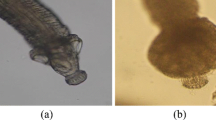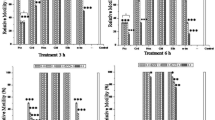Abstract
Echinostomiasis is a food-borne intestinal, snail-mediated parasitosis caused principally by ingestion of snails infected with digenean trematodes of the Echinostoma genus. The treatment and control of trematodiasis is usually done by administration of praziquantel (PZQ). In this study, we evaluated the effect on Echinostoma paraensei of different doses of praziquantel through analysis of morphological parameters using light microscopy, scanning electron microscopy, and confocal scanning laser microscopy along with parasitological data. We used 30 female mice aged 4 weeks. Each animal was given 40 metacercarie of E. paraensei by gavage. The animals were divided into five groups, each group containing six animals, where one group was utilized as untreated control. Two weeks after infection, the mice were given praziquantel by gavage at total dosages of 12.5, 25, 50 or 100 mg/kg by body weight. Two days after treatment, the mice were euthanized in a CO2 chamber for recovery of helminths in the small intestine. The doses of 50 and 100 mg/kg of praziquantel eliminated all the worms. There were significant differences (p < 0.05) between all the treated groups when compared to the control group. The body morphology showed contraction with vacuolization of the parenchyma, and the spine of the peristomic collar was not evident by light microscopy. The scanning electron microscopy revealed that the other doses caused retraction of spines of the peristomic collar and also the tegument spines at the body edge, as well as the development of vesicles and peeling; all these alterations were more evident at the dose of 25 mg/kg. In turn, the confocal scanning laser microscopy revealed vacuolization and disorganization of spines and vitelline glands. E. paraensei responds differently to experimental treatment with praziquantel according to the doses utilized causing morphological alteration and even worm elimination.



Similar content being viewed by others
References
Cioli D, Botros SS, Francklow KW, Mbaye A (2004) Determination of ED50 values for praziquantel in praziquantel-resistant and susceptible Schistossoma mansoni isolate. Int J Parasitol 34:979–987
Drescher K, Rogers EJ, Bruce JL, Katz N (1993) Response of drug-resistant isolates of Schistosoma mansoni to antischistosomal agents. Mem Inst Oswaldo Cruz 88:89–99
Ellery AW (1985) Guidelines for specification of animals and husbandry methods when reporting the results of animal experiments. Working for the Biological Caracterization of Laboratory Animal/GV-SOLAS. Lab Anim 19:106–108
Fallon PG, Mubarak JS, Fookes RE, Niang M (1997) Schistosoma mansoni: maturation rate and drug susceptibility of different geographic isolates. Exp Parasitol 86:29–36
Fujino T, Fried B, Hosier DW (1994) The expulsion of Echinostoma trivlovis (Trematoda) from ICR mice: extension/retraction mechanisms and ultrastructure of collar spines. Parasitol Res 80:581–587
Graczyc TK, Fried B (1998) Echinostomiasis: a common but forgotten food-borne disease. Am J Trop Mes Hyg 58:501–504
Keiser J, Brun R, Fried B, Utzinger J (2006) Trematocidal activity of praziquantel and artemisinin derivatives: in vitro and in vivo investigations with adult Echinostoma caproni. Antimicrob Agents Chemother 50:803–805
Lie KJ, Basch PF (1967) The life history of Echinostoma paraensei sp (Trematoda: Echinostomatidae). J Parasitol 53:1192–1199
Lutz A (1924) Estudos sobre a evolução dos Endotrematodes brazileiros. Mem Inst Oswaldo Cruz 17:55–73
Mafra AC, Lanfredi RM (1998) Reevaluation of Physaloptera bispiculata (Nematoda: Spiruroidadea) by light and scanning electron microscopy. J Parasitol 84:582–588
Maldonado A Jr, Lanfredi RM (2009) Echinostomes in the wild. In: Fried B, Toledo R (eds) The Biology of Echinostomes from the Molecule to the Community. Springer, New York, pp 129–145
Maldonado A Jr, Locker ES, Morgan JTA, Rey L, Lanfredi RM (2001) Description of adult worms of a new Brazilian isolate of Echinostoma paraensei (Platyhelmintes: Digenea) from its natural vertebrate host Nectomys squamipes by light and scanning electron microscopy and molecular analysis. Parasitol Res 87:840–848
Maldonado A Jr, Vieira GO, Lanfredi RM (2003) Echinostoma luisreyi n.sp. (Platyhelminthes: Digenea) by light and electron microscopy. J Helminthol 89:800–808
Neves RH, Alencar ACMB, Águila MB, Mandarim-Lacerda CA, Machado-Silva JR, Gomes DC (2007) Light and confocal microscopic observations of adult Schistosoma mansoni from mice fed on a high-fat diet. J Helmintol 81:361–368
Nollen PM (1996) Mating behaviour of Echinostoma caproni and Echinostoma paraensei in concurrent infections in mice. J Helminthol 70:133–136
Shuhua X, Binggui S, Chollet J, Tanner M (2000) Tegumental changes in adult Schistosoma mansoni harboured in mice treated with praziquantel enantiomers. Acta Trop 76:107–117
Souza JG, Garcia JS, Manso PP, Neves RH, Maldonado A Jr, Machado-Silva JR (2011) Development of the reproductive system of Echinostoma paraensei in Mesocricetus auratus analized by light and confocal scanning laser microscopy. Exp Parasitol 128:341–346
Taweethavonsawat P, Chungpivat S, Satranarakun P, Traub RJ, Schaper R (2010) Efficacy of a combination product containing pyrantel, febantol and praziquantel (Drontal® Plus Flavour, Bayer Animal Health) against experimental infection with the hookworm Ancylostoma ceylanicum in dog. Parasitol Res 106:533–537
Xiao SH, Mei JY, Jiao PY (2009) The in vitro effect mefloquine and praziquantel against juvenile and adult Schistosoma japonicum. Parasitol Res 106:273–246
Xiao SH, Mei JY, Jiao PY (2011a) Schistosoma japonicum-infected hamsters (Mesocricetus auratus) used as a model in experimental chemotherapy with praziquantel, artemether and OZ compounds. Parasitol Res 108:431–437
Xiao SH, Mei JY, Jiao PY (2011b) Effect of mefloquine administered orally at single, multiple, or combined with artemether, artusunate, or praziquantel in treatment of mice infected with Schistosoma japonicum. Parasitol Res 108:399–406
Xiao SH, Xue J, Xu LI, Zang YN, Qiang HQ (2011c) Comparative effect of mebendazole, albedazole, tribendimidine and praziquantel in treatment of rats infected with Clonorchis sinensis. Parasitol Res 108:723–730
Acknowledgments
The authors would like to thank the financial support given by the Conselho Nacional de Desenvolvimento Científico e Tecnológico (CNPq) and the Fundação Carlos Chagas Filho de Amparo à Pesquisa do Estado do Rio de Janeiro (FAPERJ).
Author information
Authors and Affiliations
Corresponding author
Additional information
Arnaldo Maldonado Jr. has a fellowship from the National Council for Scientific and Technological Development (CNPq).
This is in memoriam to Reinalda Lanfredi.
Rights and permissions
About this article
Cite this article
Ferraz, J., Souza, J., Costa-Silva, M. et al. Effect of praziquantel on adult Echinostoma paraensei worms in experimentally infected mice. Parasitol Res 111, 143–148 (2012). https://doi.org/10.1007/s00436-011-2810-9
Received:
Accepted:
Published:
Issue Date:
DOI: https://doi.org/10.1007/s00436-011-2810-9




